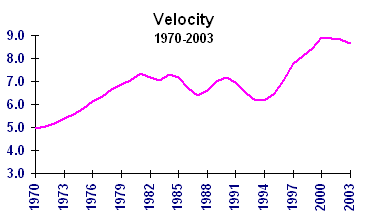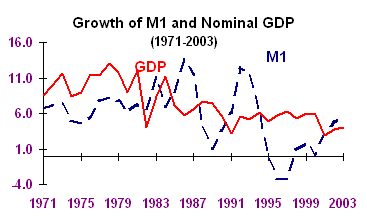The debate between Monetarists and Keynesians hinges on the stability of velocity and the efficiency of markets.
Velocity has been unstable and unpredictable since the early 1980s.
|
|

Which school of thought is right, Keynesians or Monetarists? The answer hinges
on the two assumptions described above: the stability of velocity and the efficiency of markets. We address the first of these two assumptions here. The figure titled "Velocity" plots velocity of M1 from 1970 to 2003. In the 1970s velocity was not stable, but at least it was increasing at a fairly constant rate.
Monetarism relies on the predictability of velocity rather than absolute stability, so in the 1970s one could make a case for the short-run quantity theory. However, the 1980s and 1990s have not been kind to Monetarist assumptions. Velocity was highly unstable with unpredictable periods of increases and declines. In such an environment, the link between the money supply and nominal GDP broke down and the usefulness of the quantity theory of money came into question. Many economists who were convinced by Friedman and Monetarism in the 1970s abandoned this approach in the mid- to late-1980s. The empirical relationship had simply broken down. Why?
 Most economists think the breakdown was primarily the result of changes in banking rules and other financial innovations. In the 1980s banks were allowed to offer interest-earning checking accounts and many people chose to hold their wealth in the form of M1. In short, the distinction between checking and savings accounts partially eroded. Moreover, many people found that money
markets, mutual funds and other assets were better alternatives to traditional bank deposits. Hence, the relationship between money and economic performance changed. The figure titled "Growth of M1 and Nominal GDP" illustrates the lack of correlation between money growth and nominal GDP growth since the mid-1980s. Monetarists and Keynesians alike closely watch the behavior of velocity. If velocity should become more stable in the future, there is no reason that monetarism could not make a resurgence. The Federal Reserve would be thrilled to have an indicator that predicts economic
activity so accurately.
Most economists think the breakdown was primarily the result of changes in banking rules and other financial innovations. In the 1980s banks were allowed to offer interest-earning checking accounts and many people chose to hold their wealth in the form of M1. In short, the distinction between checking and savings accounts partially eroded. Moreover, many people found that money
markets, mutual funds and other assets were better alternatives to traditional bank deposits. Hence, the relationship between money and economic performance changed. The figure titled "Growth of M1 and Nominal GDP" illustrates the lack of correlation between money growth and nominal GDP growth since the mid-1980s. Monetarists and Keynesians alike closely watch the behavior of velocity. If velocity should become more stable in the future, there is no reason that monetarism could not make a resurgence. The Federal Reserve would be thrilled to have an indicator that predicts economic
activity so accurately.
|


 implies that velocity is fixed in the short run. By making this simple assumption, we have transformed the equation of exchange into the Quantity Theory of Money. This equation tells us that any change in M1 will impact P × Y. Changes in the money supply are the dominant forces that change nominal GDP (P × Y). It is not surprising, therefore, that monetarists view control of the money supply as the key variable in stabilizing the economy.
implies that velocity is fixed in the short run. By making this simple assumption, we have transformed the equation of exchange into the Quantity Theory of Money. This equation tells us that any change in M1 will impact P × Y. Changes in the money supply are the dominant forces that change nominal GDP (P × Y). It is not surprising, therefore, that monetarists view control of the money supply as the key variable in stabilizing the economy.


 Most economists think the breakdown was primarily the result of changes in banking rules and other financial innovations. In the 1980s banks were allowed to offer interest-earning checking accounts and many people chose to hold their wealth in the form of M1. In short, the distinction between checking and savings accounts partially eroded. Moreover, many people found that money
markets, mutual funds and other assets were better alternatives to traditional bank deposits. Hence, the relationship between money and economic performance changed. The figure titled "Growth of M1 and Nominal GDP" illustrates the lack of correlation between money growth and nominal GDP growth since the mid-1980s. Monetarists and Keynesians alike closely watch the behavior of velocity. If velocity should become more stable in the future, there is no reason that monetarism could not make a resurgence. The Federal Reserve would be thrilled to have an indicator that predicts economic
activity so accurately.
Most economists think the breakdown was primarily the result of changes in banking rules and other financial innovations. In the 1980s banks were allowed to offer interest-earning checking accounts and many people chose to hold their wealth in the form of M1. In short, the distinction between checking and savings accounts partially eroded. Moreover, many people found that money
markets, mutual funds and other assets were better alternatives to traditional bank deposits. Hence, the relationship between money and economic performance changed. The figure titled "Growth of M1 and Nominal GDP" illustrates the lack of correlation between money growth and nominal GDP growth since the mid-1980s. Monetarists and Keynesians alike closely watch the behavior of velocity. If velocity should become more stable in the future, there is no reason that monetarism could not make a resurgence. The Federal Reserve would be thrilled to have an indicator that predicts economic
activity so accurately.